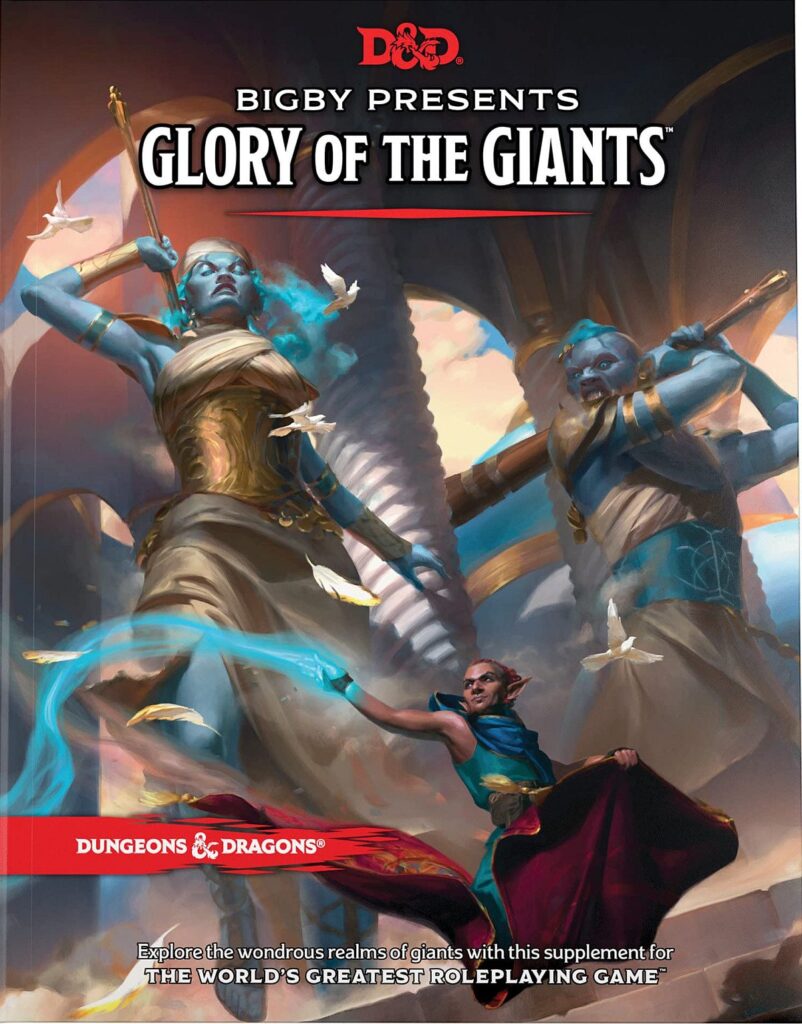I recently saw a commentator on 5E be very disappointed at the character options in Bigby Presents: Glory of the Giants. And it made me think: What do you release when an edition is ending and the new one is soon releasing?
Funnily enough, it’s not something that has come up that many times in the history of Dungeons & Dragons.
When OD&D transitioned into AD&D, TSR weren’t releasing that many products anyway.
When AD&D transitioned into AD&D 2E, TSR kept releasing adventures and DM-focused material, because they didn’t release many player-focused supplemental books. (It’s possible that the only one in the entire run of AD&D 1E is Unearthed Arcana, though the Dungeoneer’s Survival Guide and the Wilderness Survival Guide might count). There are a few transitional books like Greyhawk Adventures as well.
When AD&D 2E transitioned into D&D 3E, TSR was bankrupt, and Wizards were trying to rebuild the brand. There’s a bunch of “end of the world” adventures there. This was also the first time that two editions of the game were incredibly incompatible.
When D&D 3E transitioned into D&D 3.5E, Wizards hadn’t actually released many books. Most of the firehose of 3E books came during the 3.5E time. Wizards partly bridged the transition by releasing some really weird books that wouldn’t fit into their regular schedule, which explains Ghostwalk. Other books were looking forward to the changes. Sort of.
When D&D 3.5E transitioned into D&D 4E, the second time there was a major break in compatibility, the last months of 3.5E were filled with wild ideas and experiments. Book of Nine Swords, Tome of Magic, and Magic of Incarnum. Some of them were actually really wonderful, others failed incredibly.
When D&D 4E transitioned into D&D 5E, which is the third time there’s a break, D&D 4E had been such a failure that Wizards had stopped releasing books for it two years previously! They’d filled in the time with releasing reprints of old editions and lore-heavy books. And doing a lot of promoting the D&D Next playtest. Which, I must say, was a lot of fun.
So, now we’ve got D&D 5E transitioning into D&D whatever-you-call-it. One D&D? D&D 6E? D&D 5.1?
What type of books can they release? And the best answer is “anything that works with both version of the game.”
Do you know the type of book that will work the worst? It’s the character-focussed book, especially one that has subclasses in it.
As much as we DMs like having all the rules line up, I’d say most of us are always tweaking things, even if unconsciously, to make the game run smoothly. There’s a lot to keep track of on the DM side of things, and I am certainly used to forgetting one little rule or another. Heck, if the players can’t remember about the concentration rules when they’re only controlling one character, how am I meant to handle running 12 Red Wizards at once?
Many of the rules we interact with are on the level of “How do I resolve this situation in an adventure.” If the rules change, the situation stays the same, it’s just the methods become different. And in the case of a minor edition change, that probably won’t be hard to resolve.
But on the player side of things? Ah, things become substantially trickier there. I would say most of the rules in the game are player-focussed, which is to say, they affect what the players can do. In particular, they are centred around character classes. And when you change the rules of a character class, then any supplemental material that relies on that class may no longer function as intended.
This is immediately apparent when you consider the One D&D playtest documents. About every character class has major changes (few more so than the Warlock). And this causes a lot of problems for subclasses, especially when the levels the subclasses grant abilities change – or there are more such levels!
We’re also in the process of getting a major redesign to feat availability. You’ll see that most of the new backgrounds published now come with a bonus feat. The manner in how that works is still changing – for instance, in Shadow of the Dragon Queen, the two new backgrounds have dedicated feats, while characters with other backgrounds get their choice of “Skilled” or “Tough”, instead of choosing any feat they like (as some other implementations have allowed).
So, releasing new character material when the ground underneath you is changing is incredibly tricky. This is especially true when it’s a soft change, where old material is meant to be still useable with the new game.
So, I’m not that surprised that Bigby Presents: Glory of the Giants is relatively light on character material.
It’s rather interesting to look at what character elements can be created during this transition period. Feats are slightly problematic, and I think should mostly wait until One D&D is released (but just watch them prove me wrong). Spells are likely easier, strangely enough, as their power levels have more tolerance. New classes? I’d be so surprised!
And Magic Items lie in the hands of the DM to award, so they properly are DM-facing rather than player-facing (despite players getting the most use from them).
Which then brings us to The Deck of Many Things, which is meant to have more character options. Hmm. My speculation may be incredibly inaccurate!
But still, the books we know are coming are mostly DM-facing. I guess I’ll discover how accurate I am once August rolls around.


Surely “The complete book of …” sets of books were all player focused 2ed material. and there were lots of them.
They weren’t released just before the edition change. (They’d had years of being useful).